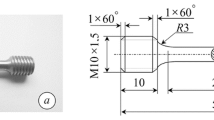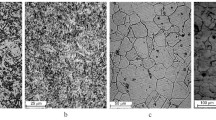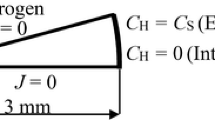We establish basic regularities of the influence of hydrogen concentration in metals on the fracture strength of low-alloy pipe steels. In particular, we determine the characteristic value of hydrogen concentration for which the mechanism of its influence on the deformation of specimens by uniaxial quasistatic tension changes, namely, below this concentration, hydrogen enhances the plasticity of the material and, above this concentration, promotes its embrittlement. For the first time, we detected an ambiguous relationship between fatigue crack-growth rate and the volume hydrogen concentration in these steels under cyclic loading in hydrogen-containing media and established its value for which the cyclic crack growth resistance of steel increases. We revealed a correlation between the intensity of hydrogenation of steels and the strength of passive film at the crack tip, which gives us an instrument for the development of efficient barriers against hydrogen penetration into the materials.















Similar content being viewed by others
References
G. Mulder, J. Hetland, and G. Lenaers, “Towards a sustainable hydrogen economy: Hydrogen pathways and infrastructure ,” Int. J. Hydrogen Energy, 32, No. 10–11, 1324–1331 (2007).
B. Somerday, P. Sofronis, and R. Jones (editors), Effects of Hydrogen on Materials, ASM Int., Materials Park, Ohio, USA (2009).
B. P. Somerday and P. Sofronis (editors), Hydrogen-Materials Interaction, ASME Press, New York (2014).
J. Capelle, I. Dmytrakh, and G. Pluvinage, “Comparative assessment of electrochemical hydrogen absorption by pipeline steels with different strength,” Corr. Sci., 52, No. 5, 1554–1559 (2010).
J. Capelle, I. Dmytrakh, Z. Azari, and G. Pluvinage, “Evaluation of electrochemical hydrogen absorption in welded pipe with steel API X52,” Int. J. Hydrogen Energy, 38, No. 33, 14356–14363 (2013).
J. Capelle, J. Gilgert, I. Dmytrakh, and G. Pluvinage, “The effect of hydrogen concentration on fracture of pipeline steels in presence of a notch,” Eng. Fract. Mech., 78, No. 2, 364–373 (2011).
J. Capelle, J. Gilgert, I. Dmytrakh, and G. Pluvinage, “Sensitivity of pipelines with steel API X52 to hydrogen embrittlement,” Int. J. Hydrogen Energy, 33, No. 24, 7630–7641 (2008).
I. M. Dmytrakh, O. D. Smiyan, A. M. Syrotyuk, and O. L. Bilyy, “Relationship between fatigue crack growth behaviour and local hydrogen concentration near crack tip in pipeline steel,” Int. J. Fatigue, 50, 26–32 (2013).
I. M. Dmytrakh, O. D. Smiyan, A. M. Syrotyuk, “Experimental study of fatigue crack growth in pipeline steel under hydrogenating conditions” [Electron resource], in: Fracture Mater. Struct. Micro Macro Scale: 18th Europ. Conf. Fracture (ECF-18), DVM, Dresden, Germany (2010).
V. V. Panasyuk, “Decohesive concept of the interaction of hydrogen with metals,” Fiz.-Khim. Mekh. Mater., 50, No. 2, 7–15 (2014); English translation: Mater. Sci., 50, No. 2, 161–169 (2014).
I. М. Dmytrakh, R. L. Leshchak, A. M. Syrotyuk, and O. L. Lutyts’kyi, “Influence of the bulk concentration of hydrogen in the metal on the specific features of deformation of low-alloy pipe steel,” Fiz.-Khim. Mekh. Mater., 50, No. 2, 16–23 (2014); English translation: Mater. Sci., 50, No. 2, 170–178 (2014).
I. Dmytrakh, A. Syrotyuk, and R. Leshchak, “Specific features of the hydrogenation and fracture strength of low-alloy steels for pipelines,” in: V. V. Panasyuk (editor), Proc. 5th Int. Sci.-Eng. Conf. “Fracture Mechanics of Materials and Strength of Structures” [in Ukrainian] (June 24–27, 2014), Karpenko Physicomechanical Institute, Ukrainian National Academy of Sciences, Lviv (2014), pp. 581–592.
I. M. Dmytrakh, R. L. Leshchak, and A. M. Syrotyuk, “Effect of hydrogen concentration on strain behaviour of pipeline steel,” Int. J. Hydrogen Energy, 40, No. 10, 4011–4018 (2015).
A. M. Syrotyuk and I. М. Dmytrakh, “Methods for the evaluation of fracture and strength of pipeline steels and structures under the action of working media,” Fiz.-Khim. Mekh. Mater., 50, No. 4, 7–17 (2014); English translation: Mater. Sci., 50, No. 4, 475–487 (2015).
I. M. Dmytrakh, M. H. Stashchuk, A. M. Syrotyuk, O. L. Bilyi, and M. I. Dorosh, “Criteria of strength and serviceability of structural steels in hydrogen-containing media with regard for their hydrogenation near defects (stress concentrators),” in: V. V. Skorokhod and Yu. M. Solonin (editors), Hydrogen in Alternative Power Engineering and New Technologies [in Ukrainian], KIM, Kyiv (2015), pp. 339–348.
I. M. Dmytrakh, R. L. Leshchak, A. M. Syrotyuk, and R. A. Barna, “Effect of hydrogen concentration on fatigue crack growth behaviour in pipeline steel,” Int. J. Hydrogen Energy, 42, No. 9, 6401–6408 (2017).
Scanning Electron Microscope Zeiss EVO-40XVP. User Manual (Version: 1.0), Carl Zeiss SMT Ltd, Cambridge (England) (2005).
H. Moustabchir, C. I. Pruncu, Z. Azari, S. Hariri, and I. Dmytrakh, “Fracture mechanics defect assessment diagram on pipe from steel P264GH with a notch,” Int. J. Mech. Mater. Design., 12, No. 2, 273–284 (2016).
P. Paris and F. Erdogan, “A critical analysis of crack propagation laws,” J. Basic Eng., 85, No. 4, 528–533 (1963).
Y. Murakami, T. Kanezaki, and Y. Mine, “Hydrogen effect against hydrogen embrittlement,” Metall. Mater. Transact., Ser. A, 41, No. 10, 2548–2562 (2010).
R. Ya. Kosarevych, O. Z. Student, L. M. Svirs’ka, B. P. Rusyn, and H. M. Nykyforchyn, “Computer analysis of characteristic elements of fractographic images,“ Fiz.-Khim. Mekh. Mater., 48, No. 4, 53–60 (2012); English translation: Mater. Sci., 48, No. 4, 474–481 (2013).
R. J. Kosarevych, B. P. Rusyn, V. V. Korniy, and T. I. Kerod, “Image segmentation based on the evaluation of the tendency of image elements to form clusters with the help of point field characteristics,” Cybern. Syst. Anal., 51, No. 51, 704–713 {2015).
A. J. Bard, M. Stratmann, and G. S. Frankel (editors), Encyclopedia of Electrochemistry, [V. 4]: Corrosion and Oxide Films, Wiley-VCH (2003).
H. Kaesche, Corrosion of Metals: Physicochemical Principles and Current Problems, Springer, Berlin (2003).
Y. Zhu, L. Li, and C. Wang, “Effects of tensile stresses on the oscillatory electrodissolution of X70 carbon steel in sulfuric acid solution,” Corr. Sci., 94, 445–451 (2015).
Q. Guo, J. Liu, M. Yu, and S. Li, “Effect of passive film on mechanical properties of martensitic stainless steel 15-5PH in a neutral NaCl solution,” Appl. Surf. Sci., 327, 313–320 (2015).
I. M. Dmytrakh, “Corrosion fracture of structural metallic materials: effect of electrochemical conditions in crack,” Strain, 47, No. 2 (Issue Supplement), 427–435 (2011).
I. M. Dmytrakh and V. V. Panasyuk, Effect of Corrosive Media on the Local Fracture of Metals Near Stress Concentrators [in Ukrainian], Karpenko Physicomechanical Institute, Ukrainian National Academy of Sciences, Lviv (1999).
G. Z. Meng, C. Zhang, and Y. F. Cheng, “Effects of corrosion product deposit on the subsequent cathodic and anodic reactions of X-70 steel in near-neutral pH solution,” Corr. Sci., 50, No. 11, 3116–3122 (2008).
M. B. Djukic, V. S. Zeravcic, G. Bakic, A. Sedmak, and B. Rajicic, “Hydrogen embrittlement of low carbon structural steel,” Proc. Mat. Sci., 3. 1167–1172 (2014).
Author information
Authors and Affiliations
Corresponding author
Additional information
Translated from Fizyko-Khimichna Mekhanika Materialiv, Vol. 54, No. 3, pp. 7–18, May–June, 2018.
Rights and permissions
About this article
Cite this article
Dmytrakh, І.М., Syrotyuk, A.М. & Leshchak, R.L. Specific Features of the Deformation and Fracture of Low-Alloy Steels in Hydrogen-Containing Media: Influence of Hydrogen Concentration in the Metal. Mater Sci 54, 295–308 (2018). https://doi.org/10.1007/s11003-018-0186-z
Received:
Published:
Issue Date:
DOI: https://doi.org/10.1007/s11003-018-0186-z




